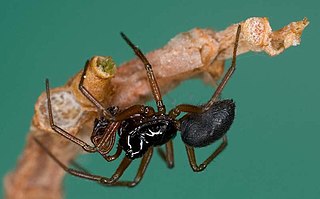
Erigoninae are the largest subfamily of sheet weavers (Linyphiidae), which is itself the second largest spider family. In the United States they are known as dwarf spiders, while they are called money spiders in England. The exact taxonomic limits of the subfamily are not yet known.

Pirate spiders, members of the family Mimetidae, are araneomorph spiders which typically feed on other spiders.
Pimoidae is a small family of araneomorph spiders first described by J. Wunderlich in 1986. As re-circumscribed in 2021, it is monophyletic, and contained 85 species in two genera. It is closely related to the Linyphiidae, and is sometimes treated as synonymous with that family.
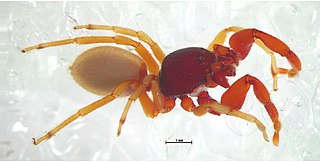
The Palpimanoidea or palpimanoids, also known as assassin spiders, are a group of araneomorph spiders, originally treated as a superfamily. As with many such groups, its circumscription has varied. As of September 2018, the following five families were included:
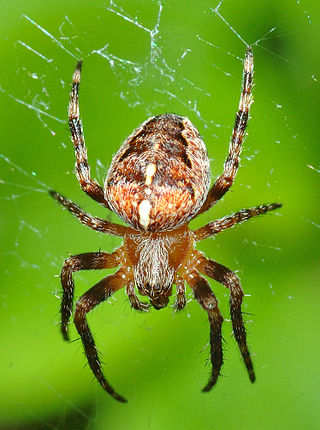
Araneoidea is a taxon of araneomorph spiders, termed "araneoids", treated as a superfamily. As with many such groups, its circumscription has varied; in particular some families that had at one time moved to the Palpimanoidea have more recently been restored to Araneoidea. A 2014 treatment includes 18 families, with the araneoids making up about 26% of the total number of known spider species; a 2016 treatment includes essentially the same taxa, but now divided into 17 families.
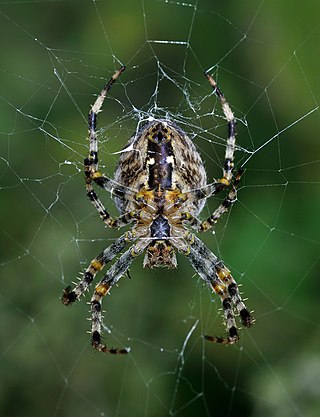
The Entelegynae or entelegynes are a subgroup of araneomorph spiders, the largest of the two main groups into which the araneomorphs were traditionally divided. Females have a genital plate (epigynum) and a "flow through" fertilization system; males have complex palpal bulbs. Molecular phylogenetic studies have supported the monophyly of Entelegynae.
Sinopimoa is a monotypic genus of Chinese sheet weavers containing the single species, Sinopimoa bicolor. It was first described by S. Q. Li & J. Wunderlich in 2008, and is found in China. It was originally placed in its own family (Sinopimoidae) but is now considered a member of the Linyphiidae, and it may be a member of the Erigoninae.

Phonognatha is a genus of South Pacific orb-weaver spiders first described by Eugène Simon in 1895. It was originally placed with the long-jawed orb weavers, and was moved to Araneidae in 2008.
Gelanor waorani is a species of neotropical spiders from South America in the family Mimetidae.
Gelanor moyobamba is a species of neotropical spiders from Peru in the family Mimetidae.
Gelanor juruti is a species of neotropical spiders from South America in the family Mimetidae.
Gelanor fortuna is a species of neotropical spider from Panama in the family Mimetidae.
Gelanor is a genus of spiders in the family Mimetidae, found in Central and South America.
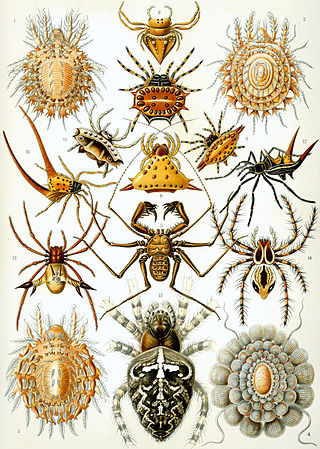
Gnolus is a genus of South American orb-weaver spiders that was first described by Eugène Louis Simon in 1879. Originally placed with the orb-weaving spiders, it was transferred to the pirate spiders in 1993, but moved back to orb-weaver family in 2012.
Selenyphantes is a genus of sheet weavers. It was first described by Willis J. Gertsch & L. I. Davis in 1946.
Anansi is a genus of African pirate spiders first described by L. R. Benavides, G. Giribet & Gustavo Hormiga in 2017. It is named after Anansi, a trickster god of Akan folklore. As of April 2019 it contains only three species.
Popperaneus is a small genus of South American orb-weaver spiders first described by J. Cabra-García and Gustavo Hormiga in 2020. As of November 2021 it contains only two species, both transferred from Wagneria: P. gavensis and P. iguape.
Diphya wesolowskae is a species of long-jawed orb weaver in the genus Diphya that lives in South Africa. First described in 2020 by Mikhail Omelko, Yuri Marusik and Robin Lyle, the spider is small, with a typical length between 2.8 and 3.17 mm. The female is larger than the male. It has a brown to dark brown and patternless carapace, which distinguishes the species from the more common Diphya simoni. The male has an abdomen that is also brown to dark brown and has a pattern of two dark spots, although some examples have more complex, but indistinct, patterns of spots and stripes. The female has a light brown abdomen marked with large spots and stripes. The copulatory organs are distinctive to the species. The female has a epigyne that lacks pockets but has a thicker septal stem than Diphya foordi, and the male has a very long, thin projection that extends from the palpal bulb beyond the cymbium and a very short embolus.






